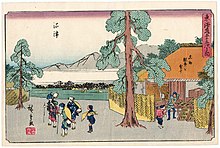Katsuobushi

Katsuobushi ( Jap. 鰹節 ), and bonito flakes is dried and smoked bonito ( Katsuwonus pelamis , a species of fish family of mackerel and tuna ) and essential for the Japanese cuisine . It is a major ingredient in the Japanese stock Dashi soup . For this purpose, this wood-like product is processed into thin flakes with a kind of upturned slicer ( katsuobushi bako ), which are boiled in water for a short time together with pieces of algae ( kombu ) to obtain the dashi. Katsuobushi flakes ( kezuribushi , 削 り 節 ) are also used directly to season dishes and are (unlike artificial products) a natural flavor enhancer . Their “ umami ” taste is mainly caused by inosine monophosphate .
Manufacturing
The manufacturing process for Katsuobushi was perfected around 1675 in Kishu (southeast of Osaka ). The fish is first filleted, then gently cooked for about 20 minutes. One hour later the bones are removed and then the bonito is smoked for up to two weeks for 6 hours a day, reducing the water content from 70% to 25%. The fish, now called arabushi ( 荒 節 ), is dried in the sun for 2–3 days and is then called hadakabushi . Last but not least, it is fermented with the help of a watering can mold (usually Aspergillus repens , but also Aspergillus ruber ) until it has reached the woody end state, whereby it is placed in the sun for some time about every two weeks to cover the fungal layer on the surface kill.
Web links
Individual evidence
- ^ A b Michael Ashkenazi, Jeanne Jacob: Food Culture in Japan. Food Culture Around the World, 2000, ISBN 978-0313324383 , p. 34.
- ^ Richard Hosking: Dictionary of Japanese Food: Ingredients & Culture. Tuttle Shokai Inc., 2014, ISBN 978-4805313350 , p. 185.
- ↑ Didier Montet (editor): Fermented Foods, Part I: Biochemistry and Biotechnology. Productivity Press, 2015, ISBN 978-1498740791 , p. 50.


